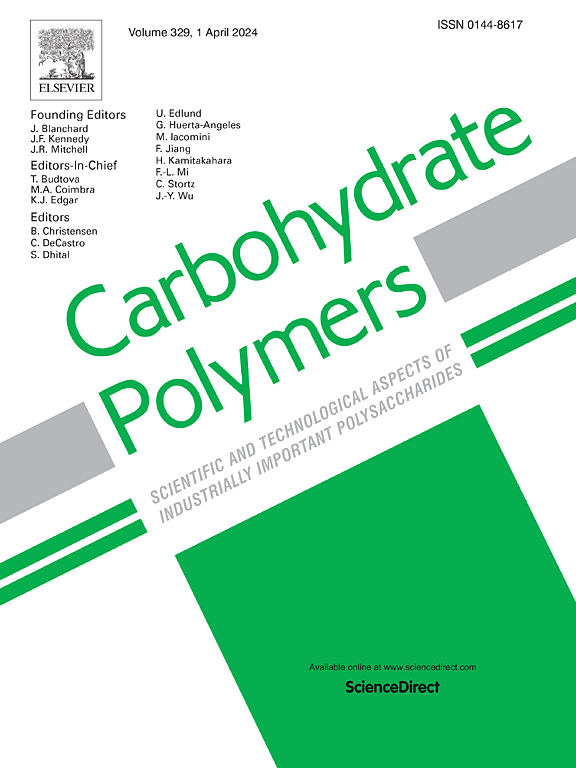超声制备多糖胶囊:揭示黄原胶-壳聚糖成壳机理
IF 10.7
1区 化学
Q1 CHEMISTRY, APPLIED
引用次数: 0
摘要
目的研究无巯基多糖(黄原胶、壳聚糖及其混合物)制备乳状胶囊的稳定机理,并比较超声与常规机械制备方法的差异。方法采用机械和超声工艺制备胶囊,并通过DLS、CLSM、低温电镜、XPS、FTIR、AFM、XRD和TGA对胶囊进行综合表征。结果超声处理后的黄原胶/壳聚糖胶囊形貌清晰(平均尺寸为1 μm),表面特性稳定(zeta电位为- 19 mV),抗聚集和聚结能力增强。结果表明,在初始聚合物溶液比为1:1时,机械制备和超声制备的黄原胶/壳聚糖比分别为1和1.17的混合壳中,不仅形成了多电解质复合物,而且显示出分子剪切效应。结构表征显示半结晶壳组织具有显著提高的机械强度,如48 kPa杨氏模量所证明的那样。胶囊具有优异的血液相容性(溶血率<;0.02 μL/mL)静脉给药应用。我们的研究结果揭示了超声作用下多糖在相界面上的行为,揭示了声能如何驱动分子重组以产生结构优越的胶囊。这项工作为基于多糖的药物载体设计提供了一个新的范例,以创建具有增强稳定性的高性能给药系统。本文章由计算机程序翻译,如有差异,请以英文原文为准。

Ultrasonic fabrication of polysaccharide capsules: Unraveling the xanthan gum-chitosan shell formation mechanism
Aim
This study establishes the mechanism of stable emulsion capsules formation using sulfhydryl-free polysaccharides (xanthan gum, chitosan, and their mixtures), comparing ultrasonic versus conventional mechanical preparation methods.
Methods
Capsules were fabricated using both mechanical and ultrasonic processing, followed by comprehensive characterization through DLS, CLSM, CRYO electron microscopies, XPS, FTIR, AFM, XRD, and TGA.
Results
Ultrasonically processed xanthan gum/chitosan capsules exhibit a well-defined morphology (1 μm average size), stable surface characteristics (−19 mV zeta potential), and enhanced resistance to aggregation and coalescence. The results demonstrate not only formation of polyelectrolyte complexes in the mixed shells (with xanthan gum/chitosan ratios of 1 and 1.17 for mechanically and ultrasonically prepared capsules, respectively, with an initial 1:1 polymer solution ratio), but also reveals molecular scissoring effects. Structural characterization reveals semi-crystalline shell organization with significantly improved mechanical strength, as evidenced by the 48 kPa Young's modulus. The capsules exhibit excellent hemocompatibility (hemolysis rate < 0.02 μL/mL) for intravenous delivery applications.
Conclusion
Our findings reveal fundamental insights into polysaccharide behavior on the phase interface under ultrasonication, demonstrating how acoustic energy drives molecular reorganization to create structurally superior capsules. This work provides a new paradigm for polysaccharide-based drug carrier design to create high-performance delivery systems with enhanced stability.
求助全文
通过发布文献求助,成功后即可免费获取论文全文。
去求助
来源期刊

Carbohydrate Polymers
化学-高分子科学
CiteScore
22.40
自引率
8.00%
发文量
1286
审稿时长
47 days
期刊介绍:
Carbohydrate Polymers stands as a prominent journal in the glycoscience field, dedicated to exploring and harnessing the potential of polysaccharides with applications spanning bioenergy, bioplastics, biomaterials, biorefining, chemistry, drug delivery, food, health, nanotechnology, packaging, paper, pharmaceuticals, medicine, oil recovery, textiles, tissue engineering, wood, and various aspects of glycoscience.
The journal emphasizes the central role of well-characterized carbohydrate polymers, highlighting their significance as the primary focus rather than a peripheral topic. Each paper must prominently feature at least one named carbohydrate polymer, evident in both citation and title, with a commitment to innovative research that advances scientific knowledge.
 求助内容:
求助内容: 应助结果提醒方式:
应助结果提醒方式:


